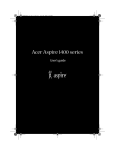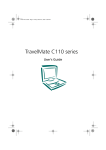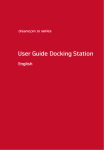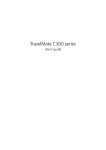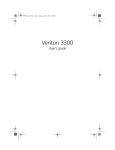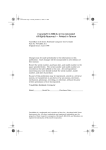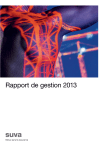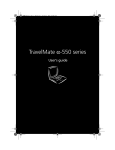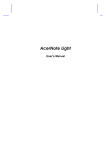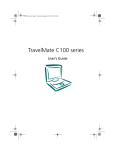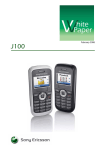Download User Guide Notebook - Brack Electronics AG
Transcript
10 series User Guide Notebook English dreamcom 10 series Notebook User Guide Technical Support Dreamcom Corporation Tittwiesenstrasse 27 7000 Chur, Switzerland Telephone: +41 81 300 43 50 Contact email: [email protected] For additional information, please visit the Dreamcom Web site: www.dreamcom.ch Copyright © 2008 Dreamcom Corporation All Rights Reserved dreamcom 10 series User Guide Original Issue: March 2008 Changes may be made periodically to the information in this publication without obligation to notify any person of such revision or changes. Such changes will be incorporated in new editions of this manual or supplementary documents and publications. This company makes no representations or warranties, either expressed or implied, with respect to the contents hereof and specifically disclaims the implied warranties of merchantability or fitness for a particular purpose. Record the model number, serial number, purchase date, and place of purchase information in the space provided below. The serial number and model number are recorded on the label affixed to your computer. All correspondence concerning your unit should include the serial number, model number, and purchase information. All other trademarks and registered trademarks are the properties of their respective companies. vii vii x 1 Getting familiar with your computer 1 A tour of your computer Top view Closed top view Left view Right view Rear view Bottom view Features 3 3 5 6 7 7 8 9 2 Using your computer Using the display Adjusting brightness Switching the video image Adjusting LCD height Indicators Using the keyboard Identifying special keys Using the touchpad Using a battery pack Battery pack characteristics Optimizing battery life Using the optical drive Connecting peripherals USB devices External monitor External keyboard External pointing device Printer Audio devices ExpressCard Smart card Docking station Securing your computer Security notch Fingerprint recognition sensor Passwords 13 15 15 15 16 18 19 19 24 26 26 29 32 34 34 34 35 35 35 35 35 36 37 38 38 38 38 Contents Preface Connecting the computer Care and maintenance iv 3 Software Launch Manager BIOS Utility 4 Replacing components 39 41 42 45 Installation precautions ESD precautions Pre-installation instructions Post-installation instructions Tool requirements Removing the battery pack Removing the lower cover Replacing a memory module Replacing the hard disk drive module Installing and removing the SIM card 47 47 48 48 49 50 51 52 54 57 5 Moving with your computer 59 Disconnecting from the desktop Moving around Preparing the computer What to bring to short meetings What to bring to long meetings Taking the computer home Preparing the computer What to bring with you Special considerations Setting up a home office Traveling with the computer Preparing the computer What to bring with you Special considerations Traveling internationally with the computer Preparing the computer What to bring with you Special considerations 6 Troubleshooting Frequently-asked questions Error messages 61 62 62 62 62 63 63 63 63 64 65 65 65 65 66 66 66 66 67 69 72 v A Specifications 77 B Notices 81 Index 87 vi vii Preface The dreamcom 10 notebook computer incorporates the latest mobile technologies in a slim and portable package. This manual should answer most of the questions you have about the dayto-day operation of your notebook computer. You should also take advantage of the online help files that are available with almost all of the programs shipped with your computer. We hope you enjoy your notebook computer. With proper care, your computer will provide you with years of productive service. Connecting the computer Connecting the computer is as easy as 1-2-3. 1. Place the computer upside down on a flat, stable surface. 2. Slide the battery cover latch toward the left (1), then remove the battery cover (2). 1 2 viii 3. Align the tabs on the battery pack with the grooves on the battery bay, then insert the battery in place. 4. Replace the battery cover. Make sure to slide the battery cover latch forward to lock the battery cover. Note: When using a battery pack for the first time, fully recharge the battery, then disconnect the adapter to use up the battery before recharging again. Perform this action twice to condition the battery pack. 5. Connect one end of the AC adapter to the DC-in port on the computer’s rear panel. 6. Connect the power cord to the AC adapter and the other end to a properly grounded power outlet. 7. Open the display by lifting up the cover then tilt it to a comfortable viewing position. Warning! Do not open the LCD display to more than 120° angle when the computer is positioned at an angle of 10° to the surface. Failure to do so may cause unit to tip over or fall and cause serious injury. The computer employs a microswitch that turns off the display (e.g., enters standby mode) to conserve power when you close the display cover, and turns it back on when you open the display cover. Caution: To avoid damaging the display, do not slam it when you close it. Also, do not place any object on top of the computer when the display is closed. ix 8. Press the power button to turn on the power. The POST (power-on self-test) routine executes and Windows begins loading. Note: To turn off the power, use the Windows Turn Off command to shut down the computer. If you are unable to shut down your computer normally, press and hold the power button for more than four seconds to turn off the computer. If you turn off the computer and want to turn it on again, wait at least two seconds before powering up. x Care and maintenance Taking care of your computer Your computer will serve you well if you take care of it. • Do not expose the computer to direct sunlight. Do not place it near sources of heat, such as a radiator. • Do not expose the computer to temperatures below 0ºC (32ºF) or above 50ºC (122ºF). • Do not subject the computer to magnetic fields. • Do not expose the computer to rain or moisture. • Do not spill water or any liquid on the computer. • Do not subject the computer to heavy shock and vibration. • Do not expose the computer to dust and dirt. • Never place objects on top of the computer to avoid damaging the computer. • Never place the computer on uneven surfaces. Taking care of your AC adapter Here are some ways to take care of your AC adapter: • Do not connect the adapter to any other device. • Do not step on the power cord or place heavy objects on top of it. Carefully route the power cord and any cables away from all potential traffic. • When unplugging the power cord, do not pull on the cord itself but pull on the plug. • The total ampere ratings of the equipment plugged in should not exceed the ampere rating of the cord if you are using an extension cord. Also, the total current rating of all equipment plugged into a single wall outlet should not exceed the fuse rating. xi Taking care of your battery pack Here are some ways to take care of your battery pack: • Use only batteries of the same kind as replacements. Turn the power off before removing or replacing batteries. • Do not tamper with batteries. Keep them away from children. • Dispose of used batteries according to local regulations. Recycle if at all possible. Cleaning and servicing When cleaning the computer, follow these steps: 1. Power off the computer. 2. Disconnect the AC adapter. 3. Remove the battery pack. 4. Use a soft cloth moistened with water. Do not use liquid or aerosol cleaners. Contact your dealer or see your service technician if any of the following occurs: • The computer has been dropped or the body has been damaged. • Liquid has been spilled into the product. • The computer does not operate normally. xii 1 Getting familiar with your computer This chapter gives an in-depth "tour" of the computer’s many features. 3 A tour of your computer Top view 1 19 2 18 3 17 16 15 14 13 4 5 6 7 8 12 9 11 10 # Item 1 Web camera Icon Description Enables you to communicate via video with people over the Internet. Note: The camera can only be used when it is turned on. 2 Display screen Also called LCD (liquid-crystal display), displays computer output. 4 1 Getting familiar with your computer # Item 3 Indicators Icon Description LEDs (light-emitting diodes) that turn on and off to show the status of the computer and its functions and components. For details on “Indicators” see page 18. 4 Fingerprint recognition sensor Identifies the authorized fingerprint. 5 Power button Turns on the computer power. 6 Mute button Mutes the sound. 7 Bluetooth button1 Enables or disables the Bluetooth function. 8 Keyboard Inputs data into your computer. 9 Touchpad Touch-sensitive pointing device which functions like a computer mouse. For details on “Using the touchpad” see page 24. 10, 11 Click buttons (left and right) The left and right buttons function like the left and right mouse buttons. 12 Palm rest Comfortable support area for your hands when you use the computer. WWAN button Enables or disables the Wireless Wide Area Network function. 13 (option)1 14 WLAN button1 Enables or disables the Wireless Local Area Network function. 15 Skype end Press to hang up or end a Skype call. button2 16 17 Skype call button2 Press to bring up the Skype window and initiate a call over Skype. Speakers Built-in speakers for rich audio sound. 5 # Item Icon Description 18 LCD slider latch Slide latch to the left to adjust the height of the LCD. 19 Akustica digital microphones Internal microphones for sound recording. 1 The Bluetooth, WWAN, and WLAN buttons are pre-set to run the wireless utility programs, but can be reset by users. To set the Bluetooth, WWAN and WLAN buttons, run the Launch Manager. See “Launch Manager” on page 41 for details. 2 Before you can use the Skype call and end buttons to place calls, you must have the Skype software installed on your computer.You can also use the Launch Manager to set both buttons to run applications. Closed top view 1 2 # Item Description 1 LCD hinge arm Supports the LCD. 2 LCD rails Connects to the hinge arm and allows you to adjust the height of the display in three height increments to ensure correct ergonomic position. 6 1 Getting familiar with your computer Left view 1 2 3 4 5 7 Icon 6 # Item Description 1 DVI port Connects to a DVI-compliant digital monitor or an analog monitor using a DVI-VGA cable. 2 USB ports Connect to USB devices (e.g., USB digital camera). 3 Headphone-out jack Connects to headphone. 4 Microphone jack Inputs sounds and voices into your computer. 5 Smart card slot Accepts a smart card module. 6 ExpressCard slot Accepts on ExpressCard/34 module. 7 Infrared port Interfaces with infrared devices (e.g. infrared printer, IR-aware computer). 7 Right view 3 2 1 # Item Description 1 Optical drive Accepts a CD or DVD. 2 LED indicator Lights up when the optical drive is active. 3 Eject button Press to eject the CD or DVD. Rear view 1 2 3 # Item Description 1 Security keylock Connects to a Kensington-compatible computer security lock. 2 DC-in jack Connects to an AC adapter. 3 Network jack Connects to an Ethernet-based network. 8 1 Getting familiar with your computer Bottom view 1 2 7 6 5 4 3 # Item Description 1 Docking alignment slots Secures the computer to the docking station. 2 Docking connector Connects the computer to a docking station. 3 HDD compartment Houses the computer’s hard disk drive. 4 Battery cover Remove cover to install the battery pack. 5 Battery cover latch Locks and releases the battery cover. 6 Memory compartment Houses the computer’s main memory. 7 SIM card compartment Allows you to install a SIM (Subscriber Identity Module) card. 9 Features This computer was designed with the user in mind. Here are just a few of its many features: Performance • Intel® CoreTM 2 Duo mobile processor with 800 MHz FSB • 15.4-inch Thin Film Transistor (TFT) LCD at 1680x1050 Wide Super eXtended Graphics Array (WSXGA+) resolution displaying 16M colors • Memory upgradeable to 4 GB with 2 DDR2 soDIMM slots • Lithium-ion battery pack • Power management system • Dual view support • Simultaneous LCD and DVI display • External display (DVI) support up to 1680x1050 resolution at 16 M colors • ATI Mobility Radeon X2600 with 256 MB VRAM VGA chipset, supporting Microsoft DirectX® 9 and DirectX 10 Multimedia • AC’97 audio system with two 1.5W speakers • SoundBlaster-Pro and DirectSound compatible Storage subsystem • High-capacity, enhanced-IDE hard disk (SATA interface) • Slot-in optical drive options: • DVD Dual drive • DVD Super Multi double-layer drive • Smart card slot • ExpressCard slot (ExpressCard/34 module) 10 1 Getting familiar with your computer Communication • CMOS web camera with two Akustica digital microphones • Skype call and Skype end button • Wireless Local Area Network (WLAN): Intel PRO Wireless 4965AGN Mini-PCI Express adapter • Wireless Personal Area Network (WPAN): Bluetooth v.2.0 adapter • Wireless Wide Area Network (WWAN): Sierra MC8775 PCI Express MiniCard Power subsystem • ACPI 3.0 CPU power management standard: supports standby (S3) and hibernation (S4) power-saving modes • 56 W 1900 mAh Li-ion battery pack • 90 W 19 V AC adapter: Express charge 90% charge in 2 hours Input devices • 86-/87-keys, inverted “T” cursor layout • Seamless touchpad pointing device • 12 function keys, four cursor keys, two Windows keys, hotkey controls, embedded numeric keypad, and international language support Connectivity • Ethernet port • Two USB 2.0 ports • IEEE 1394 (4-pin) • ExpressCard slot (ExpressCard/34 module) • Smart card slot • Infrared (IR) port • Monitor (DVI) port • Headphone/speaker/line-out jack • Microphone/line-in jack • DC-in jack for AC adapter • SIM card slot (internal) 11 Expansion • Upgradeable memory • Upgradeable hard disk Security • Fingerprint recognition sensor • Trusted platform module (TPM) • BIOS passwords Operating system and software • Microsoft Windows Vista Home Premium 64-bit • Microsoft Windows Vista Business 64-bit • Microsoft Windows Vista Ultimate 64-bit • Microsoft Windows Vista Enterprise 32-bit Options and accessories • Li-ion battery pack • AC adapter • Docking station 12 1 Getting familiar with your computer 2 Using your computer This chapter contains the information you need to know to operate the computer. 15 Using the display The graphics display offers excellent viewing, display quality and desktopperformance graphics. The computer supports a large Thin-Film Transistor (TFT) liquid crystal display (LCD) displaying up to 16 million colors at 1680x1050 WSXGA+ resolution. The power management system incorporates an "automatic LCD dim" feature that automatically dims the LCD when the computer is powered by a battery pack to conserve battery power. See “Power management” on page 31 for more information on power management features. Adjusting brightness You can conserve power by setting the brightness to the lowest comfortable setting by pressing <Fn> and the <F3> or <F4> key on the keyboard. To adjust the display brightness: • Press <Fn> + <F3> to decrease brightness of the display screen. • Press <Fn> + <F4> to increase brightness of the display. Switching the video image The computer’s crisp display and multimedia capabilities are great for viewing movies or giving presentations. If you prefer, you can also connect an external monitor when giving presentations. This computer supports simultaneous LCD and external display output via the external display port. Simultaneous display allows you to control the presentation from your computer and at the same time face your audience. You can also connect other output display devices such as LCD projection panels for largeaudience presentations. To switch the video image between internal and external monitor: Press <Fn> + <F2> to switch the video image between the display screen, external monitor (if connected) and both the display screen and external monitor. 16 2 Using your computer Adjusting LCD height The computer’s LCD hinge arm allows you to adjust the height of the LCD monitor from 56.7 mm (2.2 inch), 85.7 mm (3.4 inch), and 114.7 mm (4.5 inch) in 29 mm (1.1 inch) increments. To adjust the LCD height: Slide the LCD slider latch to the left (1) and pull the display panel to the desired height (2). 17 To return to its average height, slide the LCD slider latch to the left (1), then push down the display panel (2). Warning! When sliding down the LCD display back to its average height, be sure to keep fingers away from the grap of the LCD hinge arm and the slider latch to avoid risk of injury. Keep fingers away from the gap as you slide the LCD display down. Keep fingers away from the gap as you slide the LCD display down. 18 2 Using your computer Indicators The computer has six easy-to-read status indicators (LEDs) under the display screen. 1 Icon 2 3 4 5 6 # Indicator Description 1 Skype call Lights when a Skype call is in progress. 2 Docking indicator Lights when the computer is properly connected to the docking station. For more information on how to use the dreamcom 10 docking station, refer to the documentation that came with the docking station. 3 Caps lock Lights up when Caps Lock is activated. 4 Num lock Lights up when Numeric Lock is activated. 5 Power Indicates the computer power status. The indicator blinks when the computer is in standby mode. 6 Charge Indicates the computer’s battery is being charged. The indicator light goes off when the battery is fully charged. 19 Using the keyboard The keyboard has full-sized keys with an embedded keypad, separate cursor keys, two Windows keys and twelve function keys. Identifying special keys Lock keys 1 2 Fn The keyboard has three lock keys which you can toggle on and off. # Lock Key Description 1 Scroll Lock When Scroll Lock is on, the screen moves one line up or down when you press ↑ or ↓ respectively. Scroll Lock does not work with some applications. Num Lock Press the Fn - Scroll Lock key to turn Num Lock on. When Num Lock is on, the embedded keypad is in numeric mode. The keys function as a calculator (complete with the arithmetic operators +, -, *, and /). Use this mode when you need to do a lot of numeric data entry. A better solution would be to connect an external keypad. Caps Lock When Caps Lock is on, all alphabetic characters typed are in uppercase. 2 20 2 Using your computer Embedded numeric keypad 7 8 4 9 5 1 2 0 6 x 3 – , + The embedded numeric keypad functions like a desktop numeric keypad. It is indicated by small characters located on the upper right corner of the keycaps. To simplify the keyboard legend, cursor-control key symbols are not printed on the keys. Desired Access Num Lock On Num Lock Off Number keys on embedded keypad Type numbers in a normal manner. Cursor-control keys on embedded keypad Hold Shift while using cursorcontrol keys. Hold Fn while using cursor-control keys. Main keyboard keys Hold Fn while typing letters on embedded keypad. Type the letters in a normal manner. 21 Windows keys 2 1 The keyboard has two keys that perform Windows-specific functions. # Key Description 1 Application key Opens the application’s context menu (same as right-click). 2 Windows logo key Start button. Combinations with this key perform special functions. Below are a few examples: + Tab (Activates next Taskbar button) + E (Explores My Computer) + F (Finds Document) + M (Minimizes All) Shift + + M (Undoes Minimize All) + R (Displays Run dialog box) 22 2 Using your computer Hotkeys F1 F2 F3 F4 F5 F6 F7 F8 F9 F10 F11 F12 Fn The computer uses hotkeys or key combinations to access controls such as screen contrast and brightness, volume output and the BIOS setup utility. Hotkey Function Description Fn-F1 Sleep Puts the computer in Sleep mode, which can be defined via the advanced section of the Power Management Properties in the Windows Control Panel. Fn-F2 Display toggle Switches display output between the display screen, external monitor (if connected) and both the display screen and external monitor Fn-F3 Brightness down Decreases the screen brightness. Fn-F4 Brightness up Increases the screen brightness. Fn-F7 Volume down Decreases the speaker volume. Fn-F8 Volume up Increases the speaker volume. Fn-F9 Play/pause Plays, pauses, or resumes an audio CD or DVD. Fn-F10 Stop Stops CD or DVD playback. Fn-F11 Backward Skips to previous track/chapter. Fn-F12 Forward Skips to next track/chapter. To activate hotkeys: Press and hold the Fn key before pressing the other key in the hotkey combination. 23 Euro symbol If your keyboard layout is set to United States-International or United Kingdom or if you have a keyboard with a European layout, you can type the Euro symbol on your keyboard. Alt Gr Note for US keyboard users: The keyboard layout is set when you first set up Windows. For the Euro symbol to work, the keyboard layout has to be set to United States-International. To type the Euro symbol: 1. Locate the Euro symbol on your keyboard. 2. Open a text editor or word processor. 3. Hold Alt Gr and press the Euro symbol. Note: Some fonts and software do not support the Euro symbol. Please refer to (www.microsoft.com/typography/ EuroSymbolFAQ.mspx) for more information. 24 2 Using your computer Using the touchpad The built-in touchpad is both a pointing device that senses movement on its surface. This means the cursor responds as you move your finger on the surface of the touchpad. The central location on the palm rest provides optimum comfort and support. Touchpad basics 1 2 3 The following teaches you how to use the touchpad: • Move your finger across the touchpad (2) to move the cursor. • Press the left (1) and right (3) buttons located on the edge of the touchpad to do selection and execution functions. These two buttons are similar to the left and right buttons on a mouse. Tapping on the touchpad produces similar results. 25 Function Left button Execute Click twice quickly. Tap twice (at the same speed as double-clicking the mouse button). Select Click once. Tap once. Drag Click and hold, then use finger to drag the cursor on the touchpad. Tap twice (at the same speed as double-clicking the mouse button) and hold finger to the touchpad on the second tap to drag the cursor. Access context menu Right button Tap Click once. Note: Keep your fingers dry and clean when using the touchpad. Also keep the touchpad dry and clean. The touchpad is sensitive to finger movements. Hence, the lighter the touch, the better the response. Tapping too hard will not increase the touchpad’s responsiveness. 26 2 Using your computer Using a battery pack The computer uses a battery pack that gives you long use between charges. Battery pack characteristics The battery pack has the following characteristics: • Employs current battery technology standards The computer uses a Lithium-ion battery pack which does not have the memory effect problem of Nickel Cadmium (NiCd) batteries. Li-ion batteries consistently provide the longest battery life, best-suited for road warriors. • Battery-low warning When the battery charge level becomes low, the status indicator of the computer flashes at regular intervals. This tells you that the battery power is critically low (and you should save your work). You can correct this situation by recharging the battery pack. Whenever possible, use the AC adapter. The battery will come in handy when you travel or during a power failure. It is advisable to have an extra fully-charged battery pack available as backup. Charging modes The adapter has two charging modes: • Rapid mode The computer uses rapid charging when power is turned off and a powered AC adapter is connected to it. In rapid mode, a fully depleted battery gets 95% charged in approximately 2 hours. 27 • Charge-in-use mode When the computer is in use with the AC adapter plugged in, the computer also charges the battery pack if installed. This mode will take longer to fully charge a battery than rapid mode. In charge-in-use mode, a fully depleted battery gets 95% charged in approximately 2.5 to 4.5 hours. Note: We suggest that you charge the battery pack before retiring for the day, letting it charge overnight before traveling. This ensures a fully charged battery for use the next day. To use a battery pack for the first time: When using a battery pack for the first time, follow these steps: 1. Connect the AC adapter to a power source and to the computer and fully recharge the battery. 2. Disconnect the adapter to use up the battery before recharging again. You only need to do this once or twice with a new battery or with a battery that's been stored without being used for a long time. If the computer is to be stored for more than two weeks, we suggest you remove the battery pack. Battery power from a fully charged battery pack depletes in roughly a day with the computer in Standby mode, a month in Hibernation mode or when power is off. Warning! Do not expose battery packs to temperatures below 0ºC (32ºF) or above 60ºC (140ºF). This may adversely affect the battery pack. To install the battery pack: Important! Before removing the battery pack, make sure that you have an AC adapter connected to the computer; otherwise, turn off the computer. 1. Place the computer upside down on a flat, stable surface. 28 2 Using your computer 2. Slide the battery cover latch forward, then remove the battery cover. 3. Align the tabs on the battery pack with the grooves on the rear side of the computer, then insert the battery in place. 4. Replace the battery cover. Make sure to slide the battery cover latch forward to lock the battery cover. To remove the battery pack: See “Removing the battery pack” on page 50 for detailed instructions. To charge the battery: To charge the battery, install the battery pack and plug the AC adapter into the computer and an electrical outlet. To check the battery level: The Windows battery meter indicates the present battery level. Simply rest your cursor on the battery meter (or AC plug) icon on the taskbar to see the present charge level of your battery. 29 Optimizing battery life This section helps you get the most out of battery operation. Optimizing battery life prolongs the charge/recharge cycle and improves recharge efficiency. Follow these suggestions to optimize and maximize battery power: • Purchase an extra battery pack. • Use the AC adapter whenever possible so that the battery is reserved for on-the-go computing. • Keep the battery pack in the computer powered by the AC adapter. The constant trickle charge maintains the battery level to eliminate the battery self-discharge effect. The charge-in-use function also charges the battery pack. • Eject the PC card from the card slot when it is not in use, since the PC card draws extra power. • Store the battery pack in a cool, dry place. The recommended storage temperature for battery packs ranges from 10 to 30 ° C. The higher the storage temperature, the faster the battery pack self-discharges. • The batteries can be recharged about 400 times when used as directed. Excessive recharging decreases battery life. • Take care of your battery pack and AC adapter. See “Care and maintenance” on page x of the preface. Battery-low warning You never have to worry about battery power as long as you are using the AC adapter. However, when you operate the computer on battery power, pay extra attention to the power indicator on the display panel. During a battery-low condition, the power indicator flashes at regular intervals until battery power is depleted. Warning! Connect the AC adapter to the computer as soon as possible. Data is lost when computer power is cut off during Standby mode. 30 2 Using your computer The following table shows the recommended course of action to take when you encounter a battery-low condition. Situation Recommended Action AC adapter and power outlet available 1. Connect the AC adapter to the computer. 2. Save all necessary files. 3. Resume work. Power off the computer if you wish to recharge the battery rapidly. An extra fullycharged battery pack available 1. Save all necessary files. 2. Exit the application. 3. Power off the computer. 4. Replace the battery pack. 5. Power on the computer and resume work. AC adapter or power outlet not available 1. Save all necessary files. 2. Exit the application. 3. Power off the computer. 31 Power management This computer has a built-in power management unit that monitors system activity. System activity refers to any activity involving one or more of the following devices: keyboard, mouse, floppy drive, hard disk, peripherals connected to the serial and parallel ports, and video memory. If no activity is detected for a period of time (called an inactivity timeout), the computer stops some or all of these devices in order to conserve energy. This computer employs a power management scheme that supports ACPI (Advanced Configuration and Power Interface) which allows for maximum power conservation and maximum performance at the same time. Windows handles all power-saving chores for your computer. Advanced Configuration and Power Interface Advanced Configuration and Power Interface (ACPI) is a power management specification jointly developed by Compaq, Intel, Microsoft, Phoenix and Toshiba. ACPI enables Windows to control the amount of power given to each device attached to the computer. With ACPI, Windows can turn off peripheral devices when they are not in use, thereby saving power. Note: We recommend you enable power management to prolong your battery life. Refer to Windows help for more details. 32 2 Using your computer Using the optical drive Your computer comes with a slot-in type optical drive providing portable multimedia access. The drive allows you to watch DVD movies, and the combo drive, in addition, lets you burn your data onto a CD recordable disc. Caution: Never insert 8 cm discs into the computer’s slot-in optical drive. Only 12 cm discs are supported. To insert a disc: Keep disc flat, then align and insert the disc into the slot with the label facing upwards. The drive will begin reading data from the disc. To remove a disc: Before ejecting a disc, make sure that no programs or applications are using the disc. Then press the eject button to eject the disc. To play DVD movies: Insert a DVD movie disc into the drive and the DVD movie will automatically play after a few seconds. Important! When you launch the DVD player for the first time, the program asks you to input the region code. DVD discs are divided into 6 regions. Once your DVD drive is set to a region code, it will play DVD discs of that region only. You can set the region code a maximum of five times (including the first time), after which the last region code set will remain permanent. Recovering your hard disk does not reset the number of times the region code has been set. Refer to the table below for DVD movie region code information. Region code Country or region 1 U.S.A., Canada 2 Europe, Middle East, South Africa, Japan 3 Southeast Asia, Taiwan, Korea (South) 4 Latin America, Australia, New Zealand 5 Former U.S.S.R., parts of Africa, India 33 Region code Country or region 6 People's Republic of China Note: To change the region code, insert a DVD movie of a different region into the DVD drive. Please refer to the online help for more information. To burn CDs and DVDs: Your computer comes with a slot-in DVD Dual or DVD Super-Multi drive, allowing you to burn DVDs and CDs on your computer. Refer to the online help of the DVD or CD recording software on your hard disk for more information. 34 2 Using your computer Connecting peripherals Your computer offers excellent expansion capabilities with its built-in ports, connectors and bays. This section describes how to make connections through various options. When connecting peripherals, read the manual included with the peripheral for operating instructions. USB devices The two USB (Universal Serial Bus) 2.0 ports on the computer allow you to connect peripherals without occupying too many resources. USB 2.0 is the second generation USB standard that allows faster transfer rates and is also backward-compatible with USB 1.1 devices. Common USB devices include a mouse, keyboard, and digital camera. Before disconnecting a USB device from your computer, click on the Safely Remove Hardware icon on the taskbar and click on the device. When the device can be safely removed, disconnect the device from the computer. See your peripheral's documentation for details. External monitor You can connect an external monitor to the DVI port on the left panel. The DVI port allows you to connect a digital monitor directly. To connect an analog monitor, use a DVI-VGA cable connector. Read the monitor manual for additional instructions. Note: If an external monitor is not connected, closing the display cover puts the computer into Standby mode. To use simultaneous display: Your computer takes advantage of Windows multi-display capability, allowing you to use your computer for presentation purposes. So whatever is displayed in your computer will likewise be displayed on the other external display. Connect an external display device to the DVI port. You can then toggle the display output location by pressing Fn-F2 to make the image appear on both the computer LCD and external display device. 35 External keyboard This computer has a keyboard with full-sized keys and an embedded keypad. If you feel more comfortable using a desktop keyboard, you can connect a USB external keyboard to an available USB port. External pointing device This computer accepts a USB mouse or a similar pointing device. Simply plug it into an available USB port. Printer You can connect a USB printer to an available USB port. See your printer manual for operating instructions. Audio devices Audio devices are easy to connect to the audio ports accessible on the front of the computer. You can plug an external microphone (or an audio line-in device) into the line-in jack. Amplified speakers or headphones connect to the headphone-out jack. The line-in and line-out jack on the docking station also supports digital audio devices (S/PDIF). ExpressCard The ExpressCard slot found on the left panel of the computer accepts credit-card-sized cards that enhance the usability and expandability of the computer. ExpressCard standard was developed by a large number of PCMCIA member companies including technology leaders, system manufacturers, card manufacturers, and representatives from all other parts of the PC Card industry as the next generation of ‘plug-in’ I/O cards. The ExpressCard standard supports both the USB 2.0 and PCI Express interfaces. Note: Refer to your card’s manual for details on how to install and use the card and its functions. 36 2 Using your computer To insert an ExpressCard: 1. Hold the card label-side up with the card facing the computer. 2. Slide the card into the slot until it is seated. To remove an ExpressCard: Before ejecting a card: • Exit the application using the card. • Left-click on the Safely Remove Hardware icon on the taskbar and stop the card operation. 1. Gently press the ExpressCard module further into the ExpressCard slot to pop it out. 2. Pull out the ExpressCard module from the ExpressCard slot. Smart card The Smart card slot on the left panel of the computer accepts credit-cardsized cards that enhance the usability and expandability of the computer. A smart card is engineered to be tamper resistant. The card is embedded with a microchip for security that can store passwords, certificates, and keys. The microchip can be loaded with data and applications to identify and authenticate a user when making electronic cash payments, telephone calls on a public telephone, parking meter payments, etc. Note: Refer to your card’s manual for details on how to install and use the card and its functions. To insert a Smart card: 1. Hold the card with the gold chip facing up and aligned with the slot. 2. Slide the card into the slot until it is seated. To remove a Smart card: Before ejecting a card: • Exit the application using the card. • Left-click on the Safely Remove Hardware icon on the taskbar and stop the card operation. 37 1. Gently press the card module further into the Smart card slot to pop it out. 2. Pull out the Smart card module from the slot. Docking station The docking station transforms the dreamcom 10 into a full-featured desktop workstation. See your docking station user guide for operating instructions. 38 2 Using your computer Securing your computer Security features include hardware and software locks — a security notch, fingerprint recognition sensor, and password. Security notch A security notch located on the rear panel of the computer lets you connect a Kensington-compatible computer security lock. Wrap a computer security lock cable around an immovable object such as a table or locked drawer handle. Insert the lock into the notch and turn the key to secure the lock. Some keyless models are also available. See “Rear view” on page 7 for the location of this notch. Fingerprint recognition sensor A fingerprint recognition sensor is located beside the power button. See “Top view” on page 3 for the location of this sensor. This security feature allows only an authorized user to access the computer. For more details see the related documentation that comes with your computer. Passwords Passwords protect your computer from unauthorized access. When set, no one can access the computer without entering the correct password. There are three types of passwords you can set: • Supervisor Password secures your computer against unauthorized entry to critical parameters in the BIOS Utility. • User Password secures your computer against unauthorized use, and allows limited access to the BIOS Utility. • Hard Disk Password protects your data by preventing unauthorized access to your hard disk (even if the hard disk is physically removed from the computer and installed in another computer). See “About passwords” on page 43 for details. Important: Do not forget your Setup and Hard Disk password! If you forget your password, please get in touch with your dealer or an authorized service center. 3 Software This chapter discusses the important system utilities bundled with your computer. 41 Launch Manager The Launch Manager allows you to set the Bluetooth, WWAN, WLAN, Skype call, and Skype end buttons; located above the keyboard, to run other programs. You can access the Launch Manager by clicking on Start, All Programs, and then Launch Manager. Pressing on an unassigned launch key also brings up the Launch Manager. 42 3 Software BIOS Utility The BIOS Utility is a hardware configuration program built into your computer’s BIOS (Basic Input/Output System). Your computer is already properly configured and optimized, and you do not need to run this utility. However, if you encounter configuration problems, you may need to run it. Please also refer to Chapter 5, Troubleshooting when a problem arises. To activate the BIOS Utility, press F2 during POST. Navigating the BIOS Utility The main menu items are the following: • Information - displays a summary of the computer’s hardware information. • Main - contains basic settings about your computer such as date, time, and boot options. • Advanced - allows you to view and configure your drives, and I/O (input/output) ports. • Security - lets you set passwords for protecting your computer. • TPM State - lets you view and configure the TPM (Trusted Platform Module) services. • Boot - allows you to set the order in which the system boots up. • Exit - includes options to save or discard your changes, and to exit the BIOS Utility. Note: Certain parameters are highly technical. Do not make changes to parameters if you do not understand the function of the particular parameter. To enter a menu, highlight the item using the ← → keys. Within a menu, navigate through the BIOS Utility by following these instructions: • Press the cursor up/down keys (↑↓) to select item. • Press the F5 or F6 to change the value of a parameter. • Press Enter to go into a sub-menu. • Press Esc while you are in any of the menus to go one menu level higher. 43 Note: You can change the value of a parameter if it is enclosed in square brackets. Navigation keys for a menu are shown at the bottom of the screen. Please refer to the help information that displays on the Item Specific Help pane of the BIOS Utility as you select a parameter. For optimum settings, press F9 to load setup defaults; then press F10 to save the changes and exit the BIOS Utility. Note: Don’t forget your password. If you forget your password, you may have to return your notebook computer to your dealer to reset it. About passwords You can set, change or remove passwords in the Security menu. Setting a password Follow these steps: 1. Use the ↑ and ↓ keys to highlight a password parameter (Supervisor or User) and press the Enter key. The password box appears: 2. Type a password in the Enter New Password field. The password may consist of up to eight alphanumeric characters (A-Z, a-z, 0-9). Press Enter. Important: Be very careful when typing your password because the characters do not appear on the screen. 3. Re-enter the password in the Confirm New Password field, and press Enter. 4. Press Enter to accept the changes and save the password. 44 3 Software Changing or removing a password Follow these steps: 1. Use the ↑ and ↓ keys to highlight a password parameter and press Enter. The following box appears. 2. Enter the current password, then press Enter. • To change the password, type in a new password in the Enter New Password field and press Enter. Then re-enter the password in the Confirm New Password field and press Enter. • To remove the password, press Enter twice (once each in the Enter New Password and Confirm New Password fields) without typing anything in the fields. Press Enter to accept the changes. About the boot drive sequence In the Boot menu, use the cursor up/down keys (↑↓) to select a boot device, then press F5 or F6 to change its order. Items with a “+” sign can be further expanded. 4 Replacing components This chapter discusses the precautionary measures and installation procedures you need to know to upgrade the computer. 47 Installation precautions Before you remove or replace any component, we recommend that you read the following sections. These sections contain important ESD precautions along with pre-installation and post-installation instructions. ESD precautions Electrostatic discharge (ESD) can damage the processor, disk drives, mainboard, memory modules, and other notebook components. Always observe the following precautions before you install a server component. • Do not remove a component from its protective packaging until you are ready to install it. • Do not touch the component pins, leads, or circuitry. • Components with a Printed Circuit Board (PCB) assembly should always be laid with the assembly-side down. • Wear a wrist grounding strap and attach it to a metal part of the computer before handling components. If a wrist strap is not available, maintain contact with the computer throughout any procedure requiring ESD protection. • Keep the work area free of nonconductive materials, such as ordinary plastic assembly aids and foam packing. 48 4 Replacing components Pre-installation instructions Perform the steps below before you open the notebook computer or before you remove or replace any component. Warning! Failure to properly turn off the computer before you start installing components may cause serious damage. 1. Turn off power to the system and all peripherals. 2. Unplug the AC adapter and all power and signal cables from the system. 3. Place the system on a flat, stable surface. 4. Open the system according to the instructions on page 51. 5. Follow the ESD precautions described in this section when handling any component. Post-installation instructions 1. Perform the steps below after installing any component. 2. See to it that all components are installed according to the described step-by-step instructions. 3. Reinstall all hardware structure or cable that have been previously removed. 4. Reinstall the lower cover. 5. Reconnect the necessary cable. 6. Turn on the system. 49 Tool requirements We recommend that you have the following tools ready. • Flathead screwdriver (2.4mm) • Phillips screwdriver (#00, #0, or #1) • Plastic flathead screwdriver 50 4 Replacing components Removing the battery pack 1. Turn the base unit over. 2. Slide the battery cover latch forward, then remove the battery cover. 3. Gently pull on the tape attached to the battery and lift the battery out. 51 Removing the lower cover 1. See “Removing the battery pack” on page 50. 2. Remove the eight screws on the lower cover. 3. Use a plastic screwdriver to pry open the lower cover. 4. Remove the lower cover from the main unit. 52 4 Replacing components Replacing a memory module The computer supports two DIMM sockets. Each socket supports 1 GB, 2 GB, and 4 GB DDR2-667 (PC2-5300) So-DIMM modules. 1. Perform the pre-installation instructions described on page 48. 2. See “Removing the battery pack” on page 50. 3. See “Removing the lower cover” on page 51. 4. Use your fingertips or a plastic flat screwdriver to push out the latches on each side of the DIMM socket. 5. Grasp the edges of the module then gently pull the module out of the DIMM socket. Note: Hold DIMMs only by the edges. Do not touch the components or gold edge connectors. Install DIMMs with gold-plated edge connectors only. 53 6. Align the notch in the memory module with the tab in the DIMM socket. 7. Slide the module firmly into the slot at a 45° angle and press the module downward until the clips lock in place. 8. Replace the lower cover. 54 4 Replacing components Replacing the hard disk drive module Note: Before performing any hardware upgrade, protect your data by backing up your existing hard disk drive (HDD) before installing a new hard drive. 1. Perform the pre-installation instructions described on page 48. 2. See “Removing the battery pack” on page 50. 3. Gently pull on the tape attached to the HDD and slide the module out of its bay. 4. Remove the two screws that secure the HDD to the bracket. 55 5. Slide the HDD out of the bracket. 6. Remove the new HDD from its protective packaging. 7. Slide the new HDD into the bracket. 8. Secure the HDD to the bracket with the two screws you removed earlier. 56 9. 4 Replacing components Slide the HDD module into the bay until it is fully seated. 10. Replace the battery pack. 11. Replace the battery cover. Make sure to slide the battery cover latch forward to lock the battery cover. 57 Installing and removing the SIM card The built-in SIM feature allows for wireless access to the Internet via dreamcom 10, wherever you are; as long as you’ve got cellular coverage. Note: Follow instructions provided by the network service provider. To install the SIM card: 1. Perform the pre-installation instructions described on page 48. 2. See “Removing the battery pack” on page 50. 3. See “Removing the lower cover” on page 51. 4. Remove the memory modules. See page 52. 5. Remove the new SIM card from its protective packaging. 6. Hold the SIM card label-side up with the card connector facing downward and the beveled corner fitting the upper-left corner of the slot, then slide the card into the slot until it is seated. 7. Replace the memory modules. 8. Replace the lower cover. 9. Replace the battery pack. 10. Replace the battery cover. Make sure to slide the battery cover latch forward to lock the battery cover. 58 4 Replacing components To remove the SIM card: 1. Perform the pre-installation instructions described on page 48. 2. See “Removing the battery pack” on page 50. 3. See “Removing the lower cover” on page 51. 4. Remove the memory modules. See page 52. 5. Gently press the SIM card module further into the slot to pop it out. 6. Pull out the SIM card from the slot. 7. Replace the lower cover. 8. Replace the battery pack. 9. Replace the battery cover. Make sure to slide the battery cover latch forward to lock the battery cover. 5 Moving with your computer This chapter gives you tips and hints on things to consider when moving around or traveling with your computer. 61 Disconnecting from the desktop Follow these steps to disconnect your computer from external accessories: 1. Save your work in progress. 2. Shut down the operating system. 3. Turn off the computer. 4. Disconnect the cord from the AC adapter. 5. Disconnect the keyboard, pointing device, printer, external monitor, and other external devices. 6. Disconnect the Kensington lock if you are using one to secure the computer. 62 5 Moving with your computer Moving around when you are just moving within short distances, for example, from your office desk to a meeting room Preparing the computer Before moving the computer, close and latch the display cover to place it in Standby mode. You can now safely take the computer anywhere you go within the building. To bring the computer out of Standby mode, open the display and press the power button. What to bring to short meetings A fully charged battery runs the computer for 4 hours under most circumstances. If your meeting is shorter than that, you probably do not need to bring anything with you other than the computer. What to bring to long meetings If your meeting will last longer than 4 hours or if your battery is not fully charged, you may want to bring the AC adapter with you to plug in your computer in the meeting room. If the meeting room does not have an electrical outlet, reduce the drain on the battery by putting the computer in sleep mode. Press Fn-F1 or close the display cover whenever you are not actively using the computer. Then press the power button to resume (open the display if necessary) 63 Taking the computer home when you are moving from your office to your home or vice versa Preparing the computer After disconnecting the computer from your desktop, follow these steps to prepare the computer for the trip home: 1. Remove all media from the drives. Failure to remove the media can damage the drive head. 2. Pack the computer in a protective case that can prevent the computer from sliding around and cushion it if it should fall. Caution: Avoid packing items next to the top cover of the computer. Pressure against the top cover could damage the screen. What to bring with you Unless you already have some items at home, bring the following items with you: • AC adapter and power cord • The printed user manual Special considerations Follow these guidelines to protect your computer while traveling to and from work: • Minimize the effect of temperature changes by keeping the computer with you. • If you need to stop for an extended period of time and cannot bring the computer with you, leave the computer in the trunk of the car to avoid exposing the computer to excessive heat. • Changes in temperature and humidity can cause condensation. Allow the computer to return to room temperature, and inspect the screen for condensation before turning on the computer. If the temperature change is greater than 18°F (10°C), allow the computer to come to room temperature slowly. If possible, leave the computer for 30 minutes in an environment with a temperature between outside and room temperature. 64 5 Moving with your computer Setting up a home office If you frequently work on your computer at home, it may be worthwhile to purchase a second AC adapter for use at home. With a second AC adapter, you can avoid transporting the extra weight to and from home. If you use your computer at home for significant periods of time, you might also want to add an external keyboard, monitor, or mouse. 65 Traveling with the computer when you are moving within a larger distance, for instance, from your office building to a client’s office building or traveling locally Preparing the computer Prepare the computer as if you were taking it home. Be sure the battery in the computer is charged. Airport security may require you to turn on your computer when bringing it into the gate area. What to bring with you Bring the following items with you: • AC adapter • Spare, fully charged battery packs • Additional printer driver files if you plan to use another printer Special considerations In addition to the guidelines for taking the computer home, follow these guidelines to protect your computer while traveling: • Always take the computer as carry-on luggage. • If possible, have the computer inspected by hand. The computer can safely pass through security X-ray machines, but never expose the computer to a metal detector. • Avoid exposing floppy disks to hand-held metal detectors. 66 5 Moving with your computer Traveling internationally with the computer when you are moving from country to country Preparing the computer Prepare the computer as you would normally prepare it for traveling. What to bring with you Bring the following items with you. • AC adapter • Power cords that are appropriate to the country to which you are traveling • Spare, fully charged battery packs • Additional printer driver files if you plan to use another printer • Proof of purchase, in case you need to show it to customs officials • International Travelers Warranty passport Special considerations Follow the same special considerations as when traveling with the computer. In addition, these tips are useful when traveling internationally. • When traveling in another country, check that the local AC voltage and the AC adapter power cord specifications are compatible. If not, purchase a power cord that is compatible with the local AC voltage (e.g., power rating). Do not use converter kits sold for appliances to power the computer. • If you are using the modem, check if the modem and connector is compatible with the telecommunication system of the country you are traveling in. 6 Troubleshooting This chapter instructs you on how to deal with common system problems. Read it before calling a technician if a problem occurs. Solutions to more serious problems require opening up the computer. Do not attempt to open and service the computer by yourself. Contact your dealer or an authorized service center for assistance. 69 Frequently-asked questions This is a list of possible situations that may arise during the use of your computer, and it gives easy answers and solutions to these questions. I press the power button, but the computer does not start or boot-up. Look at the power indicator: • • If it is not lit, no power is being applied to the computer. Check the following: • If you are running on battery power, it may be low and unable to power the computer. Connect the AC adapter to recharge the battery pack. • Make sure the AC adapter is plugged in properly to the computer and to the power outlet. If it is lit, check the following: • If the power indicator is lit, power is being applied to the computer. • If the power indicator is blinking, the computer is in standby mode. Press the power button to resume. • Is a non-bootable (non-system) diskette in the floppy drive? Remove or replace it with a system diskette and press Ctrl-Alt-Del to restart the system. The operating system files may be damaged or missing. Insert the startup disk you created during Windows setup into the floppy drive and press CtrlAlt-Del to restart the system. This will diagnose your system and make necessary fixes. Nothing appears on the screen. The computer’s power management system automatically blanks the screen to save power. Press any key to turn the display back on. If pressing a key does not turn the display back on, two things might be the cause: • The brightness level might be too low. Press Fn-F3 and Fn-F4 to adjust the brightness level. • The display device might be set to an external monitor. Press the display toggle hot key Fn-F2 to toggle the display back to the computer. 70 6 Troubleshooting Image is not full-screen. Make sure the resolution is set to a resolution your system supports. Rightclick on your Windows desktop and select Properties to bring up the Display Properties dialog box. Then click on the Settings tab to make sure the resolution is set to the appropriate resolution. Resolutions lower than the specified resolution are not full-screen on the computer or on an external monitor. No audio from the computer. Check the following: • The volume may be muted. In Windows, look at the volume control icon on the taskbar. If it is crossed-out, click on the icon and deselect the Mute option. • The speakers may be turned off. Press the mute button. • The volume level may be too low. Press Fn-F7 and Fn-F8 to adjust the brightness level. In Windows, look at the volume control icon on the taskbar. Click on the icon and adjust the level. If headphones, earphones or external speakers are connected to the lineout port on the computer’s left panel, the internal speakers automatically turn off. The keyboard does not respond. Try attaching an external keyboard to the USB connector on the computer. If it works, contact your dealer or an authorized service center as the internal keyboard cable may be loose. The printer does not work. Check the following: • Make sure that the printer is connected to a power outlet and it is turned on. • Make sure the printer cable is connected securely to the computer’s USB port and the corresponding port on the printer. 71 I want to set up my location to use the internal modem. To properly use your communications software (e.g., HyperTerminal), you need to set up your location: 1. Click on Start, Control Panel; then double-click on the Phone and Modem Options icon. 2. Begin setting up your location. Refer to the Windows manual. Why can’t I charge my battery to 100% charged when it is 9995% charged? To preserve the life of the battery, the system only lets you charge the battery when its capacity falls below 95%. However, it is recommended that you bring an extra battery and let the battery in the system use up its power before charging it. 72 6 Troubleshooting Error messages If you receive an error message, note the message and take the corrective action. The following table lists the error messages in alphabetical order together with the recommended course of action. Note: If your system displays one of the messages marked below with an asterisk (*), write down the message and contact your dealer. If your system fails after you have made the changes in the Setup menus, reset the computer, enter Setup and load the Setup defaults to correct the error. Error Messages Corrective Action 0200 Failure Fixed Disk Fixed disk is not working or not configured properly. Check to see if fixed disk is attached properly. Run Setup. Find out if the fixed-disk type is correctly identified. 0210 Stuck key Stuck key on keyboard. 0211 Keyboard error Keyboard not working. 0212 Keyboard Controller Failed* Keyboard controller failed test. May require replacing keyboard controller. 0213 Keyboard locked Unlock key switch Unlock the system to proceed. 0220 Monitor type does not match CMOS - Run SETUP Monitor type not correctly identified in Setup 0230 Shadow Ram Failed at offset: nnnn* Shadow RAM failed at offset nnnn of the 64k block at which the error was detected. 0231 System RAM Failed at offset: nnnn* System RAM failed at offset nnnn of in the 64k block at which the error was detected. 0232 Extended RAM Failed at offset: nnnn* Extended memory not working or not configured properly at offset nnnn. 0250 System battery is dead - Replace and run SETUP The CMOS clock battery indicator shows the battery is dead. Replace the battery and run Setup to reconfigure the system. 73 Error Messages Corrective Action 0251 System CMOS checksum bad - Default configuration used System CMOS has been corrupted or modified incorrectly, perhaps by an application program that changes data stored in CMOS. The BIOS installed Default Setup Values. If you do not want these values, enter Setup and enter your own values. If the error persists, check the system battery or contact your dealer. 0260 System timer error* The timer test failed. Requires repair of system board. 0270 Real time clock error* Real-Time Clock fails BIOS hardware test. May require board repair. 0271 Check date and time settings BIOS found date or time out of range and reset the Real-Time Clock. May require setting legal date (1991-2099). 0280 Previous boot incomplete - Default configuration used Previous POST did not complete successfully. POST loads default values and offers to run Setup. If the failure was caused by incorrect values and they are not corrected, the next boot will likely fail. On systems with control of wait states, improper Setup settings can also terminate POST and cause this error on the next boot. Run Setup and verify that the wait-state configuration is correct. This error is cleared the next time the system is booted. 0281 Memory Size found by POST differed from CMOS Memory size found by POST differed from CMOS. 02B0 Diskette drive A error 02B1 Diskette drive B error Drive A: or B: is present but fails the BIOS POST diskette tests. Check to see that the drive is defined with the proper diskette type in Setup and that the diskette drive is attached correctly. 02B2 Incorrect Drive A type - run SETUP Type of floppy drive A: not correctly identified in Setup. 02B3 Incorrect Drive B type - run SETUP Type of floppy drive B: not correctly identified in Setup. 74 6 Troubleshooting Error Messages Corrective Action 02D0 System cache error - Cache disabled RAM cache failed and BIOS disabled the cache. On older boards, check the cache jumpers. You may have to replace the cache. See your dealer. A disabled cache slows system performance considerably. 02F0: CPU ID: CPU socket number for Multi-Processor error. 02F4: EISA CMOS not writeable* ServerBIOS2 test error: Cannot write to EISA CMOS. 02F5: DMA Test Failed* ServerBIOS2 test error: Cannot write to extended DMA (Direct Memory Access) registers. 02F6: Software NMI Failed* ServerBIOS2 test error: Cannot generate software NMI (Non-Maskable Interrupt). 02F7: Fail-Safe Timer NMI Failed* ServerBIOS2 test error: Fail-Safe Timer takes too long. device Address Conflict Address conflict for specified device. Allocation Error for: device Run ISA or EISA Configuration Utility to resolve resource conflict for the specified device. Failing Bits: nnnn* The hex number nnnn is a map of the bits at the RAM address which failed the memory test. Each 1 (one) in the map indicates a failed bit. See errors 230, 231, or 232 above for offset address of the failure in System, Extended, or Shadow memory. Invalid System Configuration Data Problem with NVRAM (CMOS) data. I/O device IRQ conflict I/O device IRQ conflict error. One or more I2O Block Storage Devices were excluded from the Setup Boot Menu There was not enough room in the IPL table to display all installed I2O block-storage devices. Operating system not found Operating system cannot be located on either drive A: or drive C:. Enter Setup and see if fixed disk and drive A: are properly identified. 75 Error Messages Corrective Action Parity Check 1 nnnn* Parity error found in the system bus. BIOS attempts to locate the address and display it on the screen. If it cannot locate the address, it displays nnnn. Parity is a method for checking errors in binary data. A parity error indicates that some data has been corrupted. Parity Check 2 nnnn* Parity error found in the I/O bus. BIOS attempts to locate the address and display it on the screen. If it cannot locate the address, it displays nnnn. Press <F1> to resume, <F2> to Setup, <F3> for previous Displayed after any recoverable error message. Press <F1> to start the boot process or <F2> to enter Setup and change the settings. Press <F3> to display the previous screen (usually an initialization error of an Option ROM, i.e., an addon card). Write down and follow the information shown on the screen. Run the I2O Configuration Utility One or more unclaimed block storage devices have the Configuration Request bit set in the LCT. Run an I2O Configuration Utility (e.g. the SAC utility). If you still encounter problems after going through the corrective measures, please contact your dealer or an authorized service center for assistance. Some problems may be solved using the BIOS Setup Utility. See “BIOS Utility” on page 42. 76 6 Troubleshooting A Specifications This appendix lists the general specifications of your computer. 79 Microprocessor • Intel® CoreTM 2 Duo mobile processor with 800 MHz FSB Memory • Memory upgradeable to 4 GB with 2 DDR2-667 (PC2-5300) soDIMM slots Data storage • One high-capacity, Enhanced-IDE hard disk (SATA Interface) • Slot-in DVD Dual drive or DVD Super Multi drive • ExpressCard slot (ExpressCard/34 module) • Smart card slot Display and video • 15.4-inch TFT LCD displaying 16M colors at 1680x1050 WSXGA+ resolution • ATI Mobility Radeon X2600 with 256 MB VRAM (16M x 32 x 4 pcs) VRAM • Simultaneous LCD and DVI display • Dual display support Audio • AC’97 audio system with two 1.5W speakers • SoundBlaster-Pro and DirectSound compatible Input devices • 86-/87-keys, inverted “T” cursor layout • Seamless touchpad pointing device • 12 function keys, four cursor keys, two Windows keys, hotkey controls, embedded numeric keypad, and international language support 80 A Specifications I/O ports • One ExpressCard slot (ExpressCard/34 module) • One Smart card slot • One headphone line-out jack (3.5mm mini jack) • One microphone jack • Two USB 2.0 ports • One external monitor port (DVI) • One RJ-45 network jack (Ethernet 10/100) • One DC-in jack Weight and dimensions System • 3.537 kg including battery pack • 360 x 265 x 36~43 mm Note: Product specifications are subject to change without notice. B Notices This appendix lists the general notices of your computer. 83 Modem notice TBR 21 This equipment has been approved to Council Division 98/482/EC - “TBR 21” for pan-European single terminal connection to the Public Switched Telephone Network (PSTN). However, due to differences between the individual PSTNs provided in different countries, the approval does not, of itself, give an unconditional assurance of successful operation on every PSTN termination point. In the event of problems, you should contact your equipment supplier in the first instance. Important safety instructions 1. Read these instructions carefully. Save these instructions for future reference. 2. Follow all warnings and instructions marked on the product. 3. Unplug this product from the wall outlet before cleaning. Do not use liquid cleaners or aerosol cleaners. Use a damp cloth for cleaning. 4. Do not use this product near water. 5. Do not place this product on an unstable cart, stand, or table. The product may fall, causing serious damage to the product. 6. Slots and openings in the cabinet and the back or bottom are provided for ventilation; to ensure reliable operation of the product and to protect it from overheating, these openings must not be blocked or covered. The openings should never be blocked by placing the product on a bed, sofa, rug, or other similar surface. This product should never be placed near or over a radiator or heat register, or in a built-in installation unless proper ventilation is provided. 7. This product should be operated from the type of power indicated on the marking label. If you are not sure of the type of power available, consult your dealer or local power company. 8. Do not allow anything to rest on the power cord. Do not locate this product where persons will walk on the cord. 9. If an extension cord is used with this product, make sure that the total ampere rating of the equipment plugged into the extension cord does not exceed the extension cord ampere rating. Also, make sure that the total rating of all products plugged into the wall outlet does not exceed the fuse rating. 10. Never push objects of any kind into this product through cabinet slots as they may touch dangerous voltage points or short out parts that could result in a fire or electric shock. Never spill liquid of any kind on the product. 11. Do not attempt to service this product yourself, as opening or removing covers may expose you to dangerous voltage points or other risks. Refer all servicing to qualified service personnel. 12. Unplug this product from the wall outlet and refer servicing to qualified service personnel under the following conditions: 84 B Notices a. When the power cord or plug is damaged or frayed b. If liquid has been spilled into the product c. If the product has been exposed to rain or water d. If the product does not operate normally when the operating instructions are followed. Adjust only those controls that are covered by the operating instructions since improper adjustment of other controls may result in damage and will often require extensive work by a qualified technician to restore the product to normal condition. e. If the product has been dropped or the cabinet has been damaged f. If the product exhibits a distinct change in performance, indicating a need for service. 13. Replace the battery with the same type as the product's battery we recommend. Use of another battery may present a risk of fire or explosion. Refer battery replacement to a qualified serviceman. 14. Warning! Batteries may explode if not handled properly. Do not disassemble or dispose of them in fire. Keep them away from children and dispose of used batteries promptly. 15. Use only the proper type of power supply cord set (provided in your accessories box) for this unit. It should be a detachable type: UL listed/CSA certified, type SPT-2, rated 7A 125V minimum, VDE approved or its equivalent. Maximum length is 15 feet (4.6 meters). 16. Warning! Do not open the LCD display to more than 120° angle when the notebook computer is positioned at an angle of 10° to the surface. Failure to do so may cause unit to tip over or fall and cause serious injury. Laser compliance statement The optical drive in this computer is a laser product. The optical drive’s classification label (shown below) is located on the drive. CLASS 1 LASER PRODUCT CAUTION: VISIBLE AND INVISIBLE LASER RADIATION WHEN OPEN. AVOID EXPOSURE TO BEAM. APPAREIL A LASER DE CLASSE 1 PRODUIT LASERATTENTION: RADIATION DU FAISCEAU LASER VISIBLE ET INVISIBLE EN CAS D’OUVERTURE. EVITTER TOUTE EXPOSITION AUX RAYONS. LUOKAN 1 LASERLAITE LASER KLASSE 1 VORSICHT: SICHTBARE UND UNSICHTBARE LASERSTRAHLUNG, WENN ABDECKUNG GEÖFFNET NICHT DEM STRAHLL AUSSETZEN PRODUCTO LÁSER DE LA CLASE I ADVERTENCIA: RADIACIÓN LÁSER VISIBLE Y INVISIBLE AL SER ABIERTO. EVITE EXPONERSE A LOS RAYOS. 85 LAG 1 LASER FABRIKAT ADVARSEL: SYNLIG OG USYNLIG LASERSTRÅLING VED ÅBNING. UNDGÅ UDS/ETTELSE FOR STRÅLEN. VARO! LAVATTAESSA OLET ALTTINA LASERSÅTEILYLLE. VARNING: LASERSTRÅLNING NÅR DENNA DEL ÅR ÖPPNAD ÅLÅ TUIJOTA SÅTEESEENSTIRRA EJ IN I STRÅLEN VARNING: LASERSTRÅLNING NAR DENNA DEL ÅR ÖPPNADSTIRRA EJ IN I STRÅLEN ADVARSEL: LASERSTRÅLING NAR DEKSEL ÅPNESSTIRR IKKE INN I STRÅLEN Battery statement CAUTION Danger of explosion if battery is incorrectly replaced. Replace only with the same or equivalent type recommended by the manufacturer. Discard used batteries according to the manufacturer’s instructions. ADVARSEL! Lithiumbatteri - Eksplosionsfare ved fejlagtig håndtering. Udskiftning må kun ske med batteri af samme fabrikat og type. Léver det brugte batteri tilbage til leverandøren. ADVARSEL Eksplosjonsfare ved feilaktig skifte av batteri. Benytt samme batteritype eller en tilsvarende type anbefalt av apparatfabrikanten. Brukte batterier kasseres i henhold til fabrikantens instruksjoner. VARNING Explosionsfara vid felaktigt batteribyte. Anvãnd samma batterityp eller en ekvivalent typ som rekommenderas av apparattillverkaren. Kassera anvãnt batteri enligt fabrikantens instruktion. VAROITUS Päristo voi räjähtää, jos se on virheellisesti asennettu. Vaihda paristo ainoastaan laitevalmistajan suosittelemaan tyyppiin. Hävitä käytetty paristo valmistajan ohjeiden mukaisesti. VORSICHT! Explosionsgefahr bei unsachgemäßen Austausch der Batterie Ersatz nur durch denselben oder einem vom Hersteller empfohlenem ähnlichen Typ. Entsorgung gebrauchter Batterien nach Angaben des Herstellers. 86 B Notices Macrovision copyright protection notice This product incorporates copyright protection technology that is protected by method claims of certain U.S. patents and other intellectual property rights owned by Macrovision Corporation and other rights owners. Use of this copyright protection technology must be authorized by Macrovision Corporation, and is intended for home and other limited viewing uses only unless otherwise authorized by Macrovision Corporation. Reverse engineering or disassembly is prohibited. Apparatus Claims of U.S. Patent Nos. 4,631,603, 4,577,216, 4,819,098, and 4,907,093 licensed for limited viewing uses only. LCD pixel statement The LCD unit is produced with high-precision manufacturing techniques. Nevertheless, some pixels may occasionally misfire or appear as black or colored dots. This has no effect on the recorded image and does not constitute a malfunction. 87 Index A AC adapter caring for x connecting viii audio connecting externally 35 B battery installing 27 battery bay 8 battery pack battery-low warning 29 caring for xi characteristics 26 charge indicator 18 charging 28 charging modes 26 checking charge level 28 low conditions 30 optimizing 29 removing 28 using the first time 27 BIOS Utility 42 entering 42 navigating 42 brightness hotkeys 22 C caps lock 19 on indicator 18 care AC adapter x battery pack xi computer x charging checking level 28 modes 26 cleaning computer xi components replacement 45 post-installation instructions 48 pre-installation instructions 48 tool 49 computer bringing to meetings 62 caring for x cleaning xi connecting vii disconnecting 61 features 9 moving around 62 security 38 setting up a home office 64 taking home 63 traveling internationally 66 traveling on local trips 65 turning on viii connections AC adapter viii audio 35 computer vii keyboard, external 35 monitor 34 mouse 35 printer 35 USB 34 D dc-in jack 7 display 15 adjusting brightness 15 adjusting height 16 power management 15 simultaneous 15 switching video image 15 troubleshooting 69, 70 docking station 37 E error messages 72 ESD 47 ExpressCard 35 ejecting 36 inserting 36 F FAQ. See frequently-asked questions fingerprint sensor 38 frequently-asked questions 69 88 removing a disc H HDD P removing 54 Hibernation mode hotkey 22 hotkeys 22 I indicator lights 18 indicators 18 infrared port 6 installing battery pack 27 HDD 55 memory 53 K keyboard 19 connecting externally 35 embedded numeric keypad hotkeys 22 lock keys 19 troubleshooting 70 Windows keys 21 20 L LCD slider latch LEDs 18 5 M messages error 72 monitor connecting 34 mouse connecting externally password 38 changing in BIOS Utility 44 removing in BIOS Utility 44 setting in BIOS Utility 43 types 38 ports DVI port 6 ExpressCard slot 6 headphone-out jack 6 microphone jack 6 network jack 7 smart card slot 6 usb port 6 power turning on viii Power management 31 precautions ESD 47 installation 47 printer connecting 35 troubleshooting 70 problems 69 display 69, 70 keyboard 70 printer 70 startup 69 Q questions setting location for modem use 71 35 R N notice DVD copyright protection num lock 19 on indicator 18 numeric keypad embedded 20 86 removing battery pack 50 HDD 54 lower cover 51 memory 52 S O optical drive 32 burning CDs and DVDs inserting the disc 32 32 33 scroll lock 19 security fingerprint sensor keylock 38 passwords 38 38 89 service when to call xi simultaneous display 34 Skype call button 4 Skype end button 4 Smart card 36 ejecting 36 inserting 36 speakers troubleshooting 70 specifications 79 s-video 35 system tour bottom view 8 closed top view 5 left view 6 rear view 7 right view 7 top view 3 T touchpad 24 using 24 travel international flights local trips 65 U USB connecting 34 utility BIOS Setup 42 V volume hotkeys 22 W Windows keys 21 WLAN button 4 WWAN button 4 66 90 Switzerland, 2008









































































































